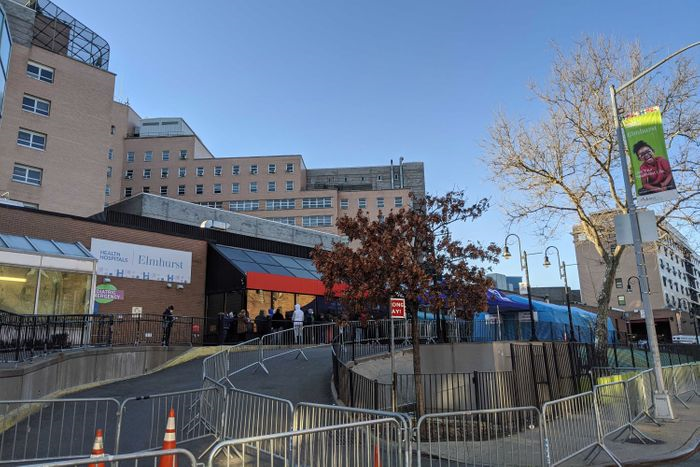
The coronavirus testing center at Elmhurst Hospital, March 21, 2020. Photo: Christine Chung/THE CITY
 By Yoav Gonen, THE CITY
By Yoav Gonen, THE CITY
This story was originally published on 3/25/20 by THE CITY
The city’s public Elmhurst Hospital in Queens has been overrun with seriously ill coronavirus patients — including 13 who died in a 24-hour span, officials said Wednesday.
A spokesperson for the city public hospital systems said Elmhurst is “at the center of this crisis,” and that the number of deaths recorded between Tuesday afternoon and Wednesday afternoon was consistent with the crush of patients.
“It’s just like a tidal wave,” said an Elmhurst Hospital doctor, who spoke on condition of anonymity. “The only beds we’ve been able to free up are people who have died.”
Queens Hit Hardest
The teaching hospital, which caters to a large immigrant community, is normally equipped to handle 15 to 20 critically ill patients between its intensive care unit (ICU) and an intermediate care unit that’s known as a stepdown.
But hospital officials have commandeered 30 additional beds in a separate unit just for seriously ill COVID-19 patients, and another 30-bed medical floor for other COVID-19 patients, according to the doctor.
“It’s a fairly dire situation. COVID is completely taking over the hospital in a way I’ve never really seen anything else do,” the doctor said.
Patch.com, which first reported on capacity issues at Elmhurst, said a dozen patients died overnight there Monday.
The doctor and another source told THE CITY additional patients who succumbed to COVID-19 on Tuesday included two people in their 30s.
NYC Health + Hospitals officials said the majority of deaths were among elderly patients and those with pre-existing conditions. They repeated their pleas for those with mild or moderate symptoms not to seek emergency care.
Queens residents account for the highest number of confirmed coronavirus cases among the boroughs — 4,667 as of late Tuesday — and the highest number of deaths, with 61, according to City Department of Health data.
That’s out of nearly 15,600 confirmed cases citywide, and 192 deaths, the data show.
‘It’s Overrun’
On Wednesday, Elmhurst hospital received about two dozen doctors and nurses from other hospitals, and a number of ventilators that help critically ill patients with their breathing, according to City Councilmember Francisco Moya (D-Queens).
“It’s very accurate to say it’s overrun. I’ve spoken to workers at the hospital and you can hear it in their voice — it’s a sign of desperation that they need help,” said Moya, who was born at the hospital, used to work there as business development director and now represents the district it’s in.
“While some assistance is coming… it’s not enough,” he added. “If we don’t address this, it’s only going to get worse. And I’m afraid of what will happen then.”
People were lined up around the corner and standing in the rain to get COVID-19 tests at Elmhurst Hospital yesterday.
This is the most overloaded hospital in the city, operating at WAY over 100% capacity and needs resources immediately—docs, nurses, PPEs, everything. pic.twitter.com/u6wfq9kkIo
— Francisco Moya (@FranciscoMoyaNY) March 24, 2020
Christopher Miller, a NYC Health + Hospitals, spokesperson said: “Elmhurst is at the center of this crisis, and it’s the number one priority of our public hospital system right now.”
“The frontline staff are going above and beyond in this crisis, and we continue surging supplies and personnel to this critical facility to keep pace with the crisis,” he added.
Personnel Shortages
Carl Ginsburg, a spokesman for the New York State Nurses Association, said his members reported a surge of patients at the Broadway hospital.
“The hospital is full. The nurses there are really slammed,” said Ginsburg, who added that the hospital is normally one of the busiest in the city.
Ginbsurg said the union’s nurses are engaging in “crash-course training” so that more of them can rotate into intensive care units throughout the city because of the growing, widespread need.
There were 660 COVID-19 patients in intensive care across the city as of late Tuesday — out of 2,850 people who were hospitalized in connection with the virus.
The doctor at Elmhurst said younger fellows and residents have often been the ones dealing with complex medical cases there. Similarly, floor nurses have been tapped to provide a higher level of intensive care than many of them were trained to handle.
“The reason they’re able to deal with the staffing is because they’re able to throw a lot of trainees into the line of fire,” said the source. “You’re asking [medical] residents to assume care of tons of complex, intubated patients.”
‘Constant Adjustments’
When asked Tuesday about which hospitals of the city’s hospitals were most “overrun,” Mayor Bill de Blasio said it wasn’t a fair word, citing Elmhurst Hospital as an example.
“I don’t like the word “overrun” because I don’t – I’m not trying to be semantically difficult, I’m just trying to be honest – I don’t think it’s a helpful word because I don’t think it portrays reality,” the mayor said on a conference call with reporters.
Invoking the name of H+H CEO Mitchell Katz, the mayor added: “Dr. Katz has been very open about the fact that there’s been a disproportionately high number of cases at Elmhurst Hospital in Queens, and yet, at the same time, it’s an extraordinary facility that’s very well run and they’ve been making constant adjustments to deal with it.”
This story was originally published by THE CITY, an independent, nonprofit news organization dedicated to hard-hitting reporting that serves the people of New York.
One Comment







We should also learn from this experience and suspend the closing or consolidation of any more hospitals in Queens, NYC and nation wide. Why not convert underutilized hospitals to learning facilities for doctors, nurses, dietitions and other hospital employees? Use them as training facilities for volunteer ambulance, National Guard and other military medical units. Mothball unused sections so they could quickly become up and running in the case of emergencies.
Since the 1980’s, I believe that the following Queens hospitals have closed. This dishonor roll includes Little Neck (previously known as Deepdale) 1996, Holliswood 2013, St Johns 2009, Kew Gardens General 1987, Parkway 2008, Mary Immaculate 2009 and Penninsula 2014. Developers and other investors benefited by some of these closings. Others could make the case that this may have been short sighted in the long term. This lost capacity could have been helpful in dealing with today’s medical emergency.
Larry Penner